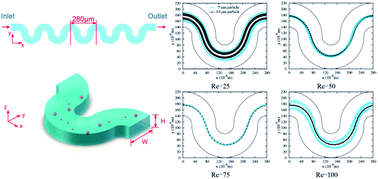Numerical simulation of particle focusing in a symmetrical serpentine microchannel
Abstract
This paper elucidates the particle focusing mechanisms in a symmetrical serpentine microchannel. The particle trajectories and the fluid fields in serpentine microchannels are explored via the numerical simulation based on a lattice Boltzmann method (LBM)-immersed boundary method (IBM) model. Experiments are also performed to verify the obtained simulation results. The investigation results help us to clearly understand the important role of the Dean flow for particle focusing in symmetrical serpentine microchannels. The balance of the inertial lift force and the Dean flow drag force at lower flow intensities leads the particles to flow near the sidewalls. As the flow intensity becomes stronger, the alternation of the Dean flow direction has special hydrodynamic effects to focus or separate particles of different sizes. Because of the volume effects, large particles are more prone to rotate with the Dean vortex and can be separated from the small particles at specific flow intensities. We envision that the simulation results of the focusing behaviors of particles would be of great significance for efficiently designing and optimizing inertial microfluidics.


 Please wait while we load your content...
Please wait while we load your content...